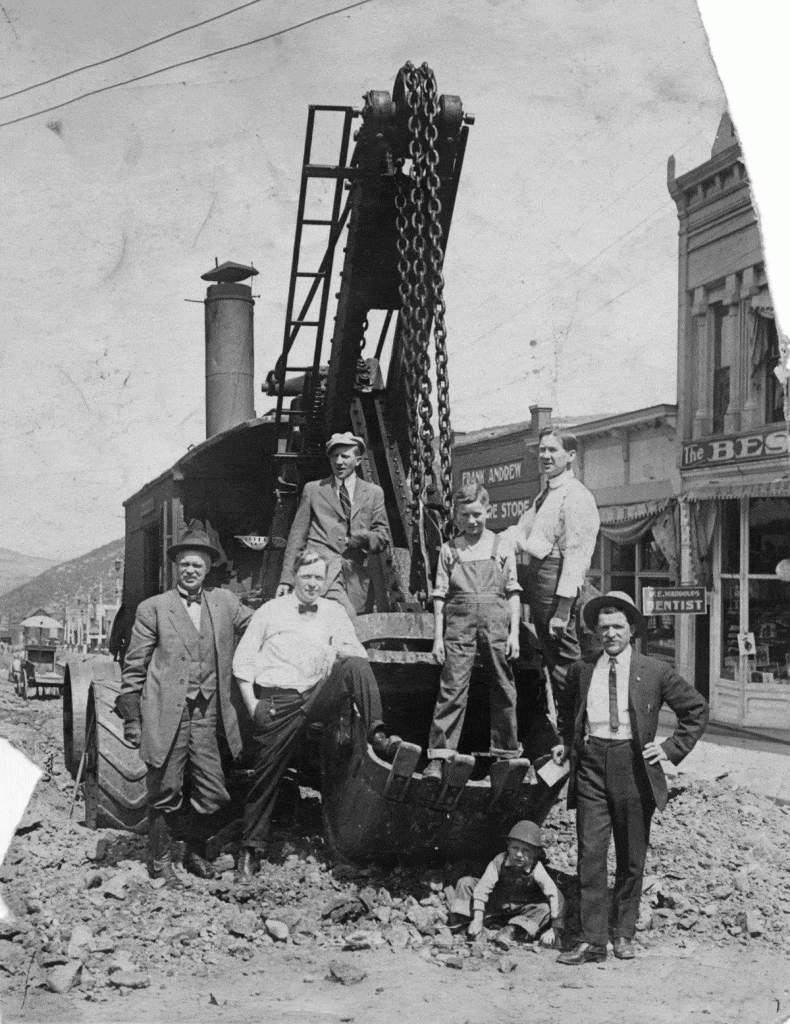While mining put Park City on the map, it took plenty of work over the years to make this town a thriving community, complete with all modern trappings.
Park City was a “modern city,” declared a billboard on Lincoln Highway in 1915. With cement sidewalks already in place, unsightly telephone poles removed, and new street lights installed, Park City was certainly well on its way. Only one thing remained: to pave the entire width of Main Street with cement.[1]
Main Street, a designated state highway, was often dusty or muddy depending on the weather. Cement paving had gained popularity throughout the country, and by the summer of 1915, it was agreed that Park City’s main thoroughfare should be paved. The city, county and state all pitched in to finance the project, with the cost estimated at $16,000.[2] Work was to begin at the bottom of Main Street and continue “as far as means and weather permit.”[3]
Delays plagued the project, but work finally commenced on Friday, August 13, 1915. A series of unfortunate events accompanied the unlucky start date. The plows failed to function properly; the work overseer was taken sick; pay per day was announced as $2.00, which workers protested mightily.[4] Also of concern was the late start date, pitting workers against the clock to beat the winter weather, and a funding shortage of $3,000, which meant the project could run out of money before the street was completed.
Despite these issues, work progressed. For the next month, Main Street saw a flurry of activity. A crusher at the Daly West dump prepared quartz, while a cement mixer came up from Davis County.

Credit: Park City Historical Society and Museum, Scholl Digital Collection
Before cement could be poured, the street required grading. The steam shovel led the way with dump carts hauling away 6,000 square feet of dirt. A steam roller and grader followed, leveling the street’s surface. The Water Master and his men repaired pipes. The State Engineer assisted with technical details. Throughout it all, crowds gathered to watch.[5]
By early September, everyone was anxious for the work to finish. Officials agreed to shift the project into high gear. The concrete men began working ten-hour days, instead of eight. A night shift was considered, as was bringing in another cement mixer. The goal was to lay 100 to 150 feet of concrete a day, instead of the usual 50 to 60 feet.[6] The Park Record exclaimed, “never was there a better crew of workmen, for they keep at it with that cheerfulness that makes work pleasant and brings results.”[7]
A month later, paving had reached Second Street. Although all parties involved had hoped to go farther, winter came sooner than expected, and work was halted until the following year, when the final stretch of Main Street was completed.
Interested in learning more about the work that built this community? The Museum is hosting The Way Park City Worked, an exhibit presented in conjunction with the Smithsonian Institution’s The Way We Worked, here through January 10, 2018. These exhibits explore twentieth-century labor history on the local and national levels. Hope to see you soon!
[1] Park Record, 1915-07-24, The Entire Width of Main Street will be Paved with Cement.
[2] Park Record, 1915-07-24, The Entire Width of Main Street will be Paved with Cement.
[3] Park Record, 1915-07-24, The Entire Width of Main Street will be Paved with Cement.
[4] Park Record, 1915-08-14, Park Float.
[5] Park Record, 1915-08-07, Park Float.
[6] Park Record, 1915-09-04, Another Extension for Street.
[7] Park Record, 1915-09-18, Paving Progress.